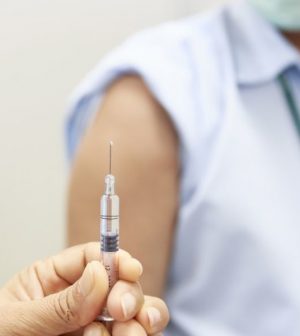- Navigating Your Midlife Crisis: Embracing New Possibilities
- City Raccoons Showing Signs of Domestication
- Mapping the Exposome: Science Broadens Focus to Environmental Disease Triggers
- One Week Less on Social Media Linked to Better Mental Health
- Your Brain Changes in Stages as You Age, Study Finds
- Some Suicide Victims Show No Typical Warning Signs, Study Finds
- ByHeart Formula Faces Lawsuits After Babies Sickened With Botulism
- Switch to Vegan Diet Could Cut Your Greenhouse Gas Emissions in Half
- Regular Bedtime Does Wonders for Blood Pressure
- Dining Alone Could Mean Worse Nutrition for Seniors
Nearly All Americans Who Got First COVID Shot Are Getting Their Second

In more good news on the coronavirus vaccine front, a new government report finds that 88% of Americans who get their first COVID-19 shot return for their second.
That bodes well for the United States, since full vaccination is vital to stopping the pandemic.
In December 2020, the Pfizer and Moderna COVID-19 vaccines were approved for emergency use, but both require two shots to get full protection. The recommended interval between doses is 21 days for Pfizer’s vaccine and 28 days for Moderna, although 42 days between doses is permissible when a delay is unavoidable, according to researchers with the U.S. Centers for Disease Control and Prevention’s COVID-19 Response Team.
To figure out if folks were indeed going back for their second shots, the team looked at vaccine administration data from Dec. 14, 2020, when the vaccines were first authorized, to Feb. 14, 2021. The first analysis included nearly 12.5 million Americans and tried to determine whether people who received a first dose, and had sufficient time to receive the second dose, had received it.
A second analysis was conducted among people who had received a second COVID-19 dose by Feb. 14, 2021, to see if the second dose was received during the recommended dosing interval. In the study, that was defined as 17 to 25 days for the Pfizer vaccine and 24 to 32 days for the Moderna vaccine.
In the first analysis, 88% had completed the series, 8.6% had not received the second dose but remained within the allowable interval, and 3.4% had missed the second dose. The percentage of people who missed the second dose was highest among American Indian/Alaska Natives (5.1%) and people aged 16 to 44 years (4%), according to CDC researcher Jennifer Kriss, and colleagues.
In the second analysis, among 14.2 million people who received a second dose, 95.6% received the dose within the recommended interval. Another 1.5% received the dose early, 2.8% received it after the recommended interval but within the allowable interval, and 0.1% received the dose late, according to the report published online March 15 in the CDC’s Morbidity and Mortality Weekly Report.
Vaccine “series completion was lowest among older adults, a finding that is similar to results from an initial nationwide examination of coverage. However, this group was also the least likely to miss the second dose; a large percentage remained within the allowable interval for the second dose,” the researchers wrote.
“Public health officials should work to better understand whether missed doses or delays are caused by challenges to vaccine access (e.g., supply, clinic availability, or community disadvantages) or because of other challenges related to vaccine confidence or acceptance,” they added.
As more Americans become eligible for vaccines, the percentage getting that second dose in a timely fashion may well drop, the researchers noted. Some strategies to help avert that situation could include scheduling second-dose appointments at the first-dose administration and sending reminders for second-dose visits, the team suggested.
As of Monday, more than 37.4 million Americans are now fully vaccinated, 11.3% of the total U.S. population, according to the CDC. Meanwhile, over 107 million, 21% of the total population, have gotten at least one dose. Just over one-third of Americans aged 65 and older are fully vaccinated, the agency reported.
More information
Visit the U.S. Centers for Disease Control and Prevention for more on COVID-19 vaccines.
SOURCE: Morbidity and Mortality Weekly Report, March 15, 2021
Source: HealthDay
Copyright © 2025 HealthDay. All rights reserved.










